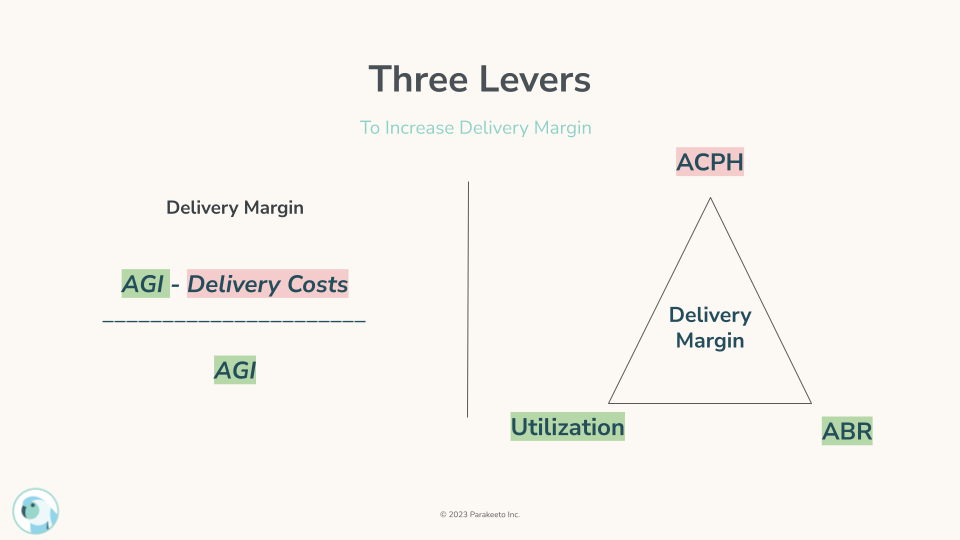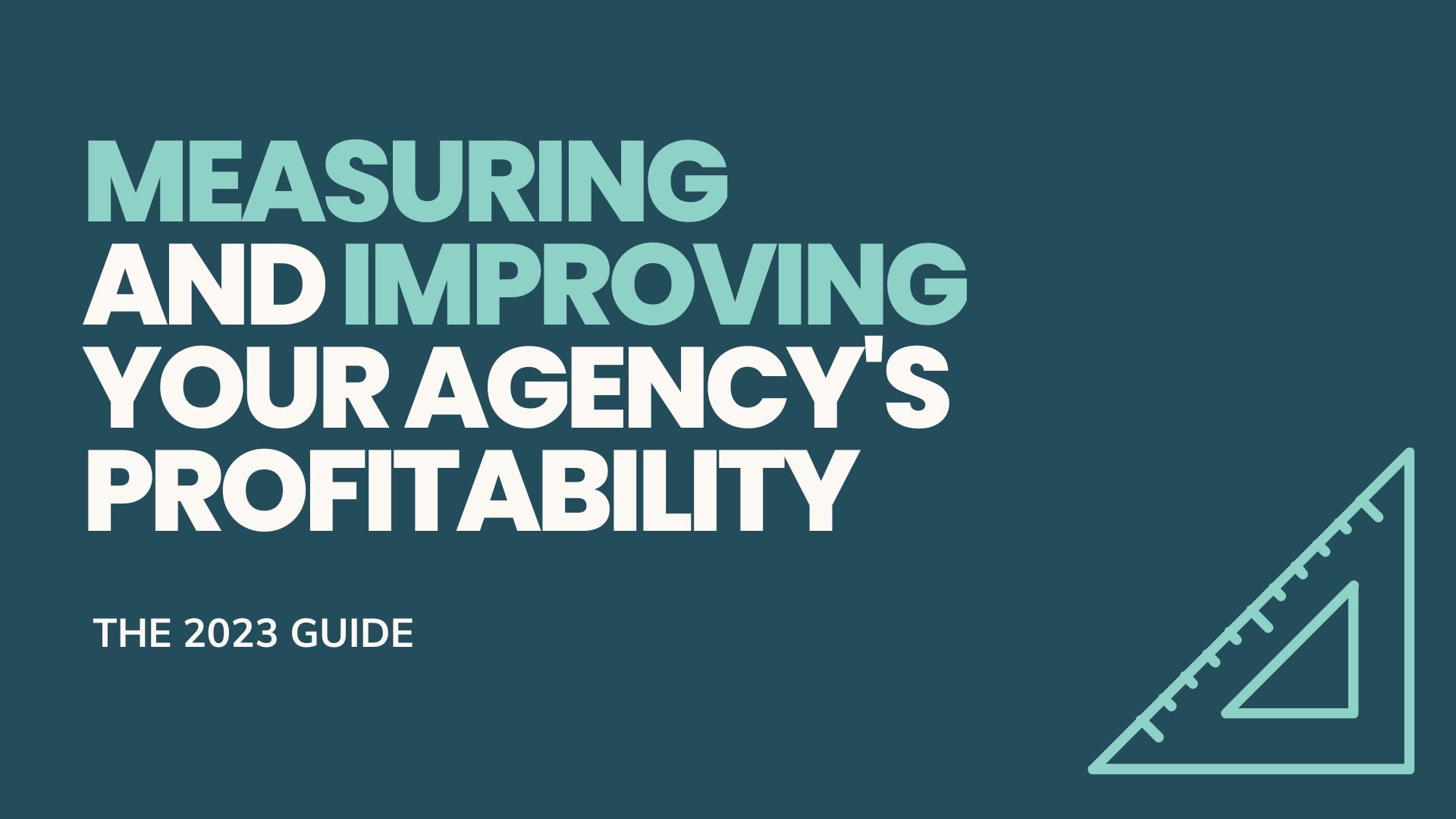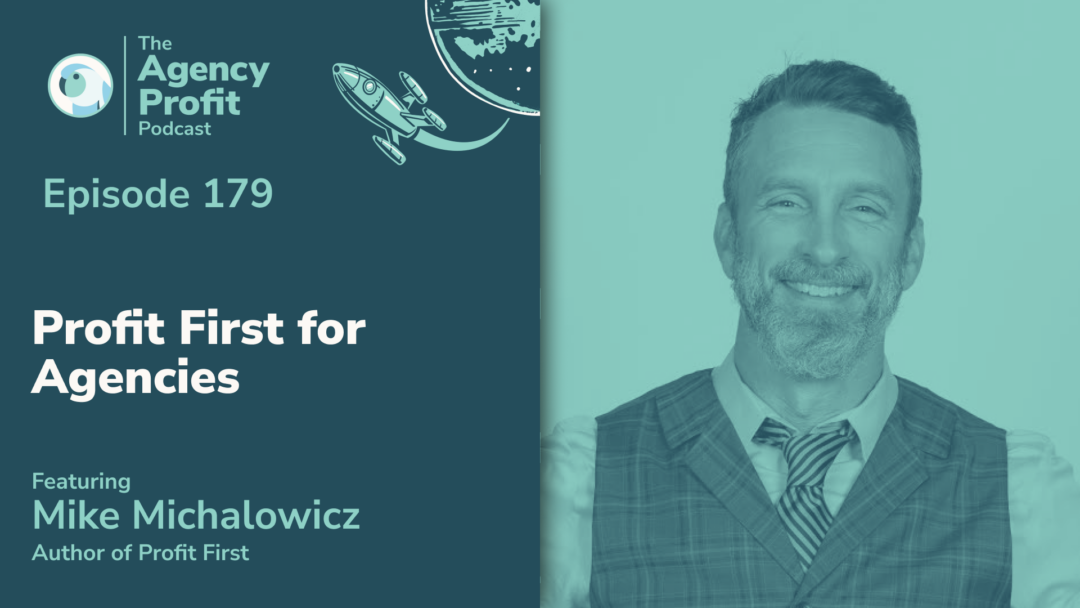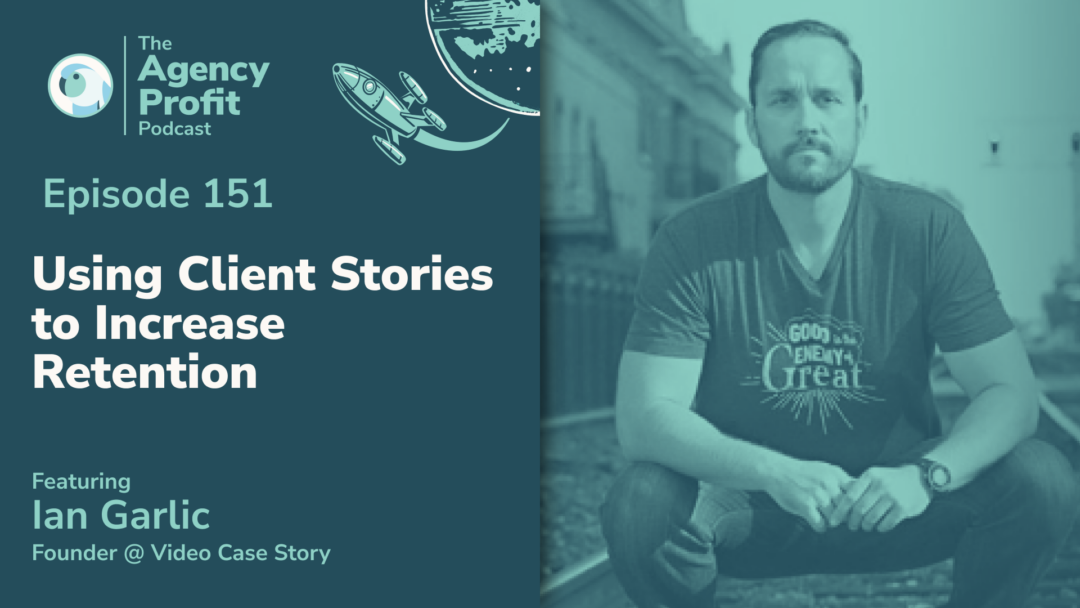Introduction
Isn’t it funny how some of the most simple questions in agency operations – like “did we make money on this project?” are some of the hardest ones to answer?
If you’re leading an agency or are on the leadership team, you know how much you could benefit from clear, consistent data at your fingertips. Running an agency is stressful enough without the added stress of making important decisions about when and how much work to sell, and your team’s livelihood based on gut feeling and outdated spreadsheets.
So how can you get there? Data can get complicated…fast. In this post, we’re going to simplify measuring and improving your agency’s profitability using just a few numbers. It will allow you to develop a clear understanding of where you stand, and to plan into the future based on what you’re seeing.
This post will truly give you the 20% of information you need to see 80% of the essentials in order to guide your firm to success. If you’ve ever been frustrated with trying to figure out things like exactly how to calculate someone’s capacity or average cost per hour, or how to effectively benchmark your rates – the answers are here, in this post.
Key Areas for Agency Operations
Agency Operations can be broken down into two key areas, at least, when it comes to the data side of it all. They are: Core Financials, and Operational Levers.
Core Financials
Financials. They’re the foundation and source of truth for you to understand fundamentally how your agency has performed. The problem though is that you may not be seeing the right numbers in your P&L that can give you the insight you need on performance.
We Audit the financials of a handful of agencies every month, and less than 10% of them are measuring things correctly. What’s more is that almost none of them are measuring their most important profitability metric at all.
So, what do you need to be seeing on your P&L to make better decisions?

Revenue
Let’s start with the very basics. You need to be able to see your Revenue number on your P&L. It tells you how much money came into the business– period. It’s important at this juncture to be able to separate what is “core” revenue attributed to the services you sell to clients, and isolate things that aren’t core to the business in “other” revenue. For example, if you’re subletting office space, earning interest on some investments, or are attempting to launch a tech startup from within your agency, all that revenue should be isolated and easily identifiable.
Example
We’re going to build an example to talk about this and the upcoming metrics. Let’s consider a marketing agency that has $1,000,000 in Revenue.
AGI (Agency Gross Income)
Now, continuing on down your P&L, you’re going to want to be able to see your AGI (Agency Gross Income) which is simply your Revenue minus any Pass-Through Expenses.
A Pass-Through Expense is any Revenue that you’re bringing into the business that your team isn’t responsible for earning. It includes things like advertising expenses for your clients, print budgets, and any spending on white label partners for services that you don’t do in-house. Your team isn’t delivering that work, and therefore it’s best to strip it out of our formulas before doing profitability calculations.
AGI is useful because it gives you an accurate portrayal of the actual income your team is responsible for earning. If you’re leaving Pass-Through Expenses in when you’re calculating profitability, you may get inflated numbers, leading to a false sense of performance/profitability.
Example
Let’s build on our marketing agency example and calculate our AGI. With $1M in Revenue, and $50k in Pass-Through Expenses, this agency has $950,000 in AGI.
$1,000,000 – $50,000 = $950,000
On most agency P&L’s we see Pass-Through Expenses are being isolated using COGS. What this means is that the “Gross Profit” line on the P&L is actually representative of AGI, not Gross Profit. Unfortunately, that’s often not clear to the agency team reading that P&L every month, and they’re often left thinking they have healthy gross profit margins, when in reality, they’re not measuring their margins at all.
That leads us to the next metric, the one almost nobody is tracking – but is by far the most important for driving healthy profitability as a services firm. I often get asked about benchmarks for AGI relative to Revenue. The simple answer is that there isn’t one, and anyone who tries to tell you there is…frankly doesn’t know what they’re talking about.
The ratio of AGI to Revenue is largely irrelevant – it’s a business model decision. The argument someone will make for minimizing pass-through expenses is that there is likely an opportunity to take that revenue in-house thereby increasing absolute profits.
However, that argument lacks nuance, it’s often a better idea to let that revenue pass-through you onto other vendors so you can focus on your core competency as an organization, remove operational drag, and focus on the higher quality revenue that you retain in AGI.
We’ve seen incredibly profitable, high-growth agencies that had 30-50% of their revenue passing through them onto other vendors. That was a deliberate choice, as there was a part of the service delivery chain they simply had no interest in doing in-house. As a result, they grew faster and had great margins relative to AGI.
At the end of the day, what’s important is the margin you retain on that AGI. Let’s unpack that further.
Delivery Margin/Delivery Profit
Once you’ve isolated your AGI, moving down your P&L you’ll want to understand what your margin is on the work you’re providing. We can start by calculating a number that we call Delivery Margin. It’s a measure of the fundamental profitability of your work, which is obtained by calculating the ratio of AGI leftover after subtracting out your Delivery Costs.
Note: Delivery Margin may be referred to as Gross Margin or Contribution Margin by your accounting team. We called it something different because we’re tired of arguing with accountants about semantics.
The Delivery Margin formula is as follows:
AGI – Delivery Costs / AGI
You can also calculate your Delivery Profit, which is simply:
AGI – Delivery Costs
Delivery Costs for your agency will be primarily composed of what it costs to staff your agency. It’s your team’s time. You may want to factor in some Shared Delivery Expenses in this calculation, as you likely have expenses that are used on the Delivery team but can’t be directly attributed to one particular project/client engagement (like a Figma subscription for your designers, or Asana for your Project Managers).
The ideal target for Delivery Margin on your P&L is 50%+.
Example
Building on our marketing agency example, let’s say that we are spending $500k on Delivery Costs per year. Here is what our Delivery Margin looks like based on that:
($950,000 – $500,000) / $950,000 = 47%
The reason most firms can’t see their delivery margin on the P&L is simple, their delivery costs aren’t being isolated. All of their payroll is lumped into one big account, with no separation between Delivery Payroll, and payroll being allocated to overhead functions such as Admin and Sales & Marketing.
Similarly, their software tends to also all get lumped into one big account, thereby hiding shared delivery expenses in overhead.
If there’s nothing else you take away from this article, it’s that it should be easy for you to isolate your Delivery Expenses in your financial reports so you can actually measure the fundamental margin of the work you do.
The benchmark for Delivery Margin on the P&L is about 50%, or whatever you need to make in order to cover overhead spending (discussed below) and hit your net profit target.
When looking at Delivery Margin on a client, project, or department level, you’ll generally want to add anywhere from 10-20% to your target to account for utilization gaps, time off and other “drop-off” that occurs between discrete areas of the agency and the aggregate P&L.
Overhead Spending
Once you’re clear on your Delivery Profit and Margin, it’s time to make sure your overhead spending is balanced. Farther down on your P&L, you’ve got all of your other costs that aren’t associated with Delivery. In other words, your Overhead Expenses.
We usually bucket Overhead Spending into three categories: Admin, Sales & Marketing, and Facilities. Here are the following loose benchmarks for how much of your AGI to spend on each of them:
- Administration: 8-12% of AGI
- S&M: 8-14% of AGI
- Facilities: 4-6% of AGI
There is no need to get caught up in precision here with exactly how much you spend in each bucket. It’s more important that summated you’re spending somewhere between 20-30% of your AGI on Overhead Expenses.
Example
Let’s say our marketing agency is spending $275,000 on Overhead each year compared to an AGI of $950,000. This represents a 29% spending, which is just within the healthy range.
The nuance here is that most of the time when we audit an agency, their overhead spending is significantly higher than this 20-30% benchmark. If you run the math for yourself, you might find the same thing.
The immediate tendency is to think “shit, we need to lower our overhead!” but often, that’s not actually the problem.
While there may be some opportunity to streamline, often the overhead spending for the agency is appropriate for the size of the team, and is balanced relative to its AGI capacity. That is to say, if this agency was hitting their utilization and average billable rate targets (discussed below) and earning enough AGI to meet its Delivery Margin targets, the overhead spending relative to that AGI number would be within the acceptable range.
The biggest issue we find when clients come to us is that they have been focused on reducing overhead costs, while their real problem lies with Delivery Margin. However, because of the way their financials are structured, they’re unable to differentiate between the two. They’re left looking at revenue and their bottom line wondering what on earth is happening in between to leave them with so little after all their hard work.
Profit
Finally, we’re left on the P&L with Profit. It’s the amount of money that you’re left with after you take your Revenue, minus out Pass-Through Expenses, Delivery Costs, Shared Delivery Expenses, and Overhead Expenses.
Generally speaking, you’re going to want to aim for a Profit of at least 20% of your AGI. High performing firms will be closer to 30%
Sadly, the industry average tends to be under 15%
Example
Our marketing agency is then leftover with $175,000 after subtracting $275k of Overhead Expenses from their Delivery Profit. This represents a 18% Profit Margin, which is decent, but there is room to improve.
$175,000 / $950,000 = 18%
That is the breakdown of what you should be able to see on your P&L. It’s common for us to see agencies thinking that their Overhead Spending is what is really bringing them down profit-wise, and in some cases that may be true to a certain extent. But in a scenario where you should feel comfortable spending 20-30% of your AGI on Overhead Spending, that means if you cut super lean, that only presents a maximum of 10% of opportunity for improvement.
| Revenue | AGI | Delivery Costs | Delivery Margin/Profit | Overhead Expenses | Profit |
| $1,000,000 | $950,000 | $500,000 | 47% / $450k | $275,000 | $175,000 |
Where the true improvements lie are in the AGI and Delivery Margin breakdowns. Let’s go through the operational levers that exist in those metrics to move the needle much more than 10%.
Hopefully by this point, you’ve been able to get a sense of what your Delivery Margin looks like. If you’re anything like the firms we speak to every week, it’s likely lower than you’d like it to be.
So the question becomes, what can you do about it?
Unfortunately, this is where the utility of financial statements falls terribly short. The cost and complexity of trying to increase visibility into more discrete areas of the business is very high, and the timeliness of the data simply isn’t good enough to empower effective insight and decision making.
This is where a focus on operations data can unlock insight into what’s driving the performance on the P&L, and provide insight in a much faster, simpler and more cost-effective way.
Pssst – want a template where you can model scenarios like the one above totally for free? The Agency Profit Toolkit has one just like it!

Grab your copy of the toolkit at the link below.
Operational Levers
There are three ways that you can improve your Delivery Margin, which is your golden ticket to profitability. Either decrease your Average Cost Per Hour (ACPH), or increase your AGI or Utilization.

Decreasing ACPH
The first (but frankly least exciting) way to increase Delivery Margin is to decrease costs while maintaining AGI. From an operational perspective, this is done by achieving lower ACPH (Average Cost Per Hour) across the business. From the project and client level, to departments, all the way up to the agency as a whole – Average Cost Per Hour acts as a nimble and simple proxy for Delivery Costs and can be a leading indicator to improvements in efficiency that will impact the P&L.
ACPH is what it costs you for one hour of your team members time. You can find a resource on how to calculate your ACPH here.
An ACPH breakdown could look like this:
| Name | Role | Annual Salary + Benefits | Annual Capacity (Hours) | ACPH |
| Tino | Client Success | $60,000 | 2080 | $29 |
| Tanya | Sr. Designer | $120,000 | 2080 | $58 |
| Trish | Jr. Designer | $75,000 | 2080 | $36 |
| Tim | Creative Dir. | $220,000 | 2080 | $105 |
| $57 avg. |
Side note: If you’re a project manager, you might have just written me off as an idiot. You’re wondering why this value is based on Total Capacity instead of some adjusted version of it that takes into account things like time off, utilization and non-billable hours.
There are several reasons for that, but the first is because the cost of those variables has already been factored into our Delivery Margin targets both on the P&L and at the project level. The second is that it dramatically decreases the cost and complexity of calculating this metric. The last is that it creates more horizontal consistency to this metric, so the ACPH of a team member isn’t constantly in flux due to outside influences like Utilization and paid time off.
In short, while this feels like a less precise way to measure this metric, it’s actually more accurate with the added benefit of being far less expensive to measure and maintain.
Now that we’ve addressed our beloved and detail oriented readers, how can we decrease this ACPH number, while delivering the same quality of work, for the same prices?
The answer is of course simple, but not easy. Get less expensive people to do a larger share of the work in your agency. If you have a mature enough product, you might achieve this by creating processes around every part of your engagements, from onboarding to feedback requests. That way, your templates and systems can allow for more junior members of the team (or outsourced teams) to pick up more and more of the process, leaving the judgment calls and nuance to the senior team members, and the tactical execution to those who cost less, and are still sharpening their skills.
Here is what a slightly restructured team could look like after you implement and delegate portions of your work:
| Name | Role | Annual Salary + Benefits | Annual Capacity (Hours) | ACPH |
| Tino | Client Success | $60,000 | 2080 | $29 |
| Teyo | Jr. Designer | $75,000 | 2080 | $36 |
| Tina | Jr. Designer | $65,000 | 2080 | $31 |
| Trey | Jr. Designer | $70,000 | 2080 | $33 |
| Tim | Creative Dir. | $220,000 | 2080 | $105 |
| $47 avg. |
If you employ a lot of contractors and freelancers, you’ll feel the impact of lowering ACPH very quickly. If your team is made up of more full-time employees, you’ll feel this impact over time as the composition of your team changes, or becomes more heavily weighted to less expensive talent as it scales.
Example
Now, by decreasing your ACPH, you’ll see a material drop in your Delivery Costs. Let’s assume that by leaning more on Junior Designers, you’ve saved around $100,000 in Delivery Costs annually. Let’s see what does to your Delivery Margin number:
| Revenue | AGI | Delivery Costs | Delivery Margin/ Delivery Profit | Overhead Expenses | Profit |
| $1,000,000 | $950,000 | $500,000 | 47% / $450k | $275,000 | $175,000 |
| $1,000,000 | $950,000 | $400,000 | 57% / $550k | $275,000 | $275,000 |
With this tweak to the team impacting Delivery Costs, we’d see a material increase in Delivery Margin and Profit.
Let’s be honest – trying to drive down the cost of the team is probably the least fun way to improve profitability, and most of us enjoy employing and working with our talented teams. So how can we increase profitability while maintaining the same delivery costs we have today?
Increasing ABR
The second, and probably one of the most important levers for measuring and improving profitability is Average Billable Rate (ABR).
ABR measures a simple question:
For each hour that your team spends on client work, how much revenue does your agency earn?
Those of you who aren’t billing by the hour might immediately be writing this metric off. However, it’s important to note that the formula is the same no matter which billing model you use. Even if you use flat rate, retainer or value-based pricing – you have an ABR and it’s calculated exactly the same way, so pay attention!
ABR’s formula is simply:
AGI / Delivery Hours = ABR
If you have a project that brings in $10,000 in AGI, and your team spent 60 hours delivering it, that was $166 earned per hour. That’s what we call your Average Billable Rate. If your team spends 75 hours to earn that same $10,000 in AGI, the ABR goes down to $133.
No matter how you bill, two things will always be true about your projects:
1. You’ll have been paid a certain amount of money
2. Your team will have spent some amount of time completing the promised work
There is an opportunity for you to increase your Average Billable Rate to impact your AGI number. An increase to AGI leads to an increase in Delivery Margin, therefore positively impacting your agency’s profitability.
Example
If we compare these projects, you’ll see some are earned more efficiently than others (despite some projects bringing in more Revenue, but being earned less efficiently):
| Project | AGI | Delivery Hours Spent | ABR |
| Project A | $10,000 | 60 | $166 |
| Project B | $20,000 | 130 | $153 |
$10,000 / 60 = $166
Where AGI is the project income minus Pass-Through, and Delivery Hours are any time your team spent working on the project (regardless of whether or not it was billed to the client).
Therefore, your two options to improve your ABR is to either increase your AGI without increasing your Delivery Hours (usually done through optimizing your pricing model):
$12,000 / 60 = $200
Or decreasing your Delivery Hours (usually done through streamlined systems, templates and processes for more efficient delivery):
$10,000 / 50 = $200
Bonus
As a bonus, you can actually bake profitability into your agency by using ABR and ACPH (both defined above) as a proxy for your Delivery Margin. This way, you’ll be able to see where your margin is being driven at the service level:
ABR – ACPH / ABR
Estimated Delivery Margin = $166 – $57 / $166
Estimated Delivery Margin = 66%
This can act as a very useful alternative for a financially measured delivery margin, both when estimating and pricing projects before they are sold to clients, as well as after a project is complete to get a sense of whether or not it performed well.
Increase Utilization
The third and final lever that you can pull to improve your Delivery Margin is to tweak your Utilization. The Utilization metric asks:
Of all of the time that I’m buying in bulk from the team, how much of that time is being used to earn revenue?
Whether or not you choose to believe it, the simple fact of professional service based firms is that we hire on skilled team members by agreeing to a salary for a specific set of time (usually 2080 hours a year) and then resell those hours at a profit for a synergistic outcome for all. It doesn’t matter how you bill, this is the underlying business model for any business that sells services.
But, one of the major problems with reselling time is that you have a challenging responsibility to be filling team members up with work. Otherwise, you’ll have a hard time staying profitable. You’re responsible to regulate and maintain your team’s Utilization.
You can calculate your team’s utilization using this calculator here.
Utilization’s formula is as follows:
Delivery Hours / Capacity
Where Delivery Hours are any time spent on client work, and Capacity is all of the time available, including vacation, time off, coffee breaks, and time working. For a typical employee, that’s 40 hours a week, for 52 weeks a year, or 2080 hours annually.
We typically like to see a weekly target agency wide for Utilization to be 65%. Annually, closer to 50%. That means that 50% of the agency’s time (as a whole, including your admin/sales/marketing teams) is going towards client work.
To increase this number, you have two options. Either sell more of your services, to load up your team members with free time, or decrease the capacity that those team members have, therefore increasing their Utilization.
Example:
A more utilized team will produce more AGI. Consider the following scenario:
| Agency | Total Capacity | Utilization | Delivery Capacity | ABR | AGI |
| Agency A | 20,800 | 50% | 10,400 | $150 | 1.56M |
| Agency B | 20,800 | 51% | 10,608 | $150 | 1.59M |
As you can see, a meager 1% increase in Utilization has a material impact on AGI earned – in this case, over $30,000 worth of revenue with that extra delivery time.
Pause – we just wanted to let you know that we offer templates and training videos on all of the above, totally for free in our Agency Profit Toolkit. It also includes replays of webinars where we go into even more detail on these metrics. Get yours for free here.
Walkthrough Example:
Let’s walk through a few basic examples of how improvements in your ACPH, ABR and Utilization can impact overall agency profitability.
Scenario 1 – Baseline
Let’s start with a baseline scenario of our marketing firm:
| Capacity | Utilization | Delivery Capacity | ABR | AGI |
| 20,000 | 50% | 10,000 | $95 | $950,000 |
And let’s see what realistic improvements we can make using all of our levers.
Scenario 2 – Increase in Utilization to 55%
Here is what a five percent increase in Utilization could do to the AGI number:
| Capacity | Utilization | Delivery Capacity | ABR | AGI |
| 20,000 | 55% | 11,000 | $95 | $1,045,000 |
Scenario 3 – Increase ABR to $105
Here is what a $10 ABR increase could do, layered on with the new Utilization Rate:
| Capacity | Utilization | Delivery Capacity | ABR | AGI |
| 20,000 | 55% | 11,000 | $105 | $1,155,000 |
Scenario 4 – Decrease in Delivery Costs by 20%
And here is what a decrease in ACPH could look like, layered onto those improvements in Utilization and ABR.
| AGI | Delivery Costs | Delivery Margin/Profit | Overhead Expenses | Profit | |
| Baseline | $950,000 | $500,000 | 47% / $450k | $275,000 | $175,000 |
| w/ Operational Improvements | $1,155,000 | $400,000 | 65% / $755k | $275,000 | $480,000 |
With these reasonably achievable tweaks, this model has found an extra $300,000 in Profit without tweaking any Overhead Spending or overworking their team.
Closing Thoughts
In conclusion, measuring and improving your agency’s profitability is easier than you may have thought. By structuring your P&L to get visibility into your Core Financials, and using the 3 Operational Levers you can simplify the process and achieve tangible results. Analyzing overhead expenses and aiming for a profit of at least 20% of AGI are also important considerations.
Decreasing the average cost per hour (ACPH) through delegation and process optimization can result in substantial savings. Increasing the average billable rate (ABR) by optimizing pricing models and streamlining delivery hours can boost your AGI. Additionally, maximizing utilization by effectively managing your team’s time and workload can significantly impact profitability.
By implementing these operational levers, you can see tangible results in your agency’s bottom line. For example, a mere 1% increase in utilization can generate a significant boost in revenue.
In summary, with a clear understanding of your agency’s financial metrics and leveraging operational levers, you have the power to drive profitability and achieve sustainable growth. By implementing these strategies, you can position your agency for long-term success in an increasingly competitive landscape.








0 Comments